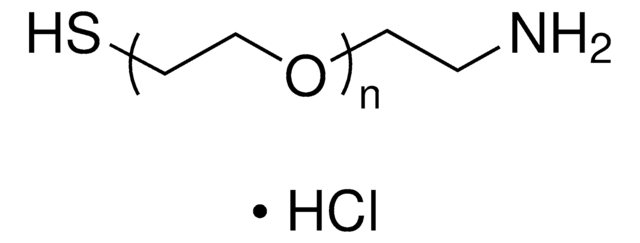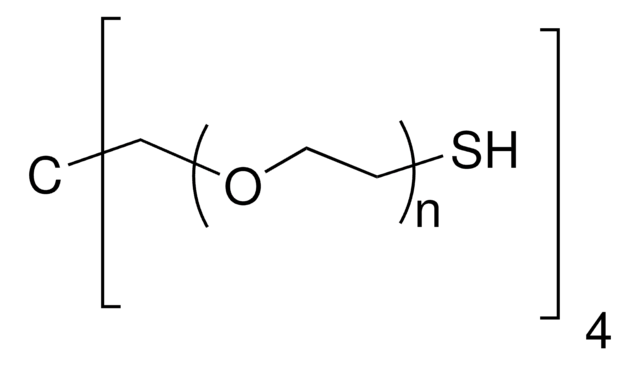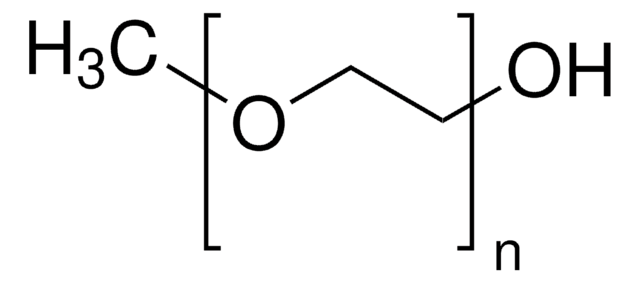729140
Poly(ethylene glycol) methyl ether thiol
average Mn 2,000, chemical modification reagent thiol reactive, methoxy, thiol
Synonym(s):
Polyethylene glycol, Methoxy PEG thiol, Methoxypolyethylene glycol thiol, PEG thiol, mPEG thiol
About This Item
Recommended Products
product name
Poly(ethylene glycol) methyl ether thiol, average Mn 2,000
form
solid
Quality Level
mol wt
average Mn 2,000
reaction suitability
reagent type: chemical modification reagent
reactivity: thiol reactive
mp
50-55 °C
Ω-end
thiol
α-end
methoxy
polymer architecture
shape: linear
functionality: monofunctional
storage temp.
−20°C
Looking for similar products? Visit Product Comparison Guide
Related Categories
Application
- Surface modification of polyaniline nanorods with thiol-terminated poly (ethylene oxide): This study explores the use of varying molecular weights of poly(ethylene glycol) methyl ether thiol for modifying the surface of polyaniline nanorods, aiming to enhance their dispersibility and functionality (DiTullio et al., 2018).
- Colorimetric determination of p-phenylenediamine using silver nanoparticles modified with poly (ethylene glycol) methyl ether thiol: The research demonstrates the use of poly(ethylene glycol) methyl ether thiol in modifying silver nanoparticles for the colorimetric determination of p-phenylenediamine, showcasing its application in analytical chemistry (Lee et al., 2017).
- Facile synthesis and self-assembly of amphiphilic polydimethylsiloxane with poly (ethylene glycol) moieties via thiol-ene click reaction: This article discusses the synthesis and self-assembly of amphiphilic copolymers using thiol-ene click chemistry, emphasizing the versatility of poly(ethylene glycol) methyl ether thiol in creating functional materials (Xia et al., 2015).
- Determination of polyethylene glycol end group functionalities by combination of selective reactions and characterization by matrix assisted laser desorption/ionization time of flight mass spectrometry (MALDI-TOF MS): This study highlights a method for characterizing end group functionalities of poly(ethylene glycol) derivatives using MALDI-TOF MS, where poly(ethylene glycol) methyl ether thiol plays a critical role in the analysis process (Zhang et al., 2014).
signalword
Warning
hcodes
Hazard Classifications
Eye Irrit. 2 - Skin Irrit. 2 - STOT SE 3
target_organs
Respiratory system
wgk_germany
WGK 3
flash_point_f
Not applicable
flash_point_c
Not applicable
Certificates of Analysis (COA)
Search for Certificates of Analysis (COA) by entering the products Lot/Batch Number. Lot and Batch Numbers can be found on a product’s label following the words ‘Lot’ or ‘Batch’.
Already Own This Product?
Find documentation for the products that you have recently purchased in the Document Library.
Customers Also Viewed
Articles
Progress in biotechnology fields such as tissue engineering and drug delivery is accompanied by an increasing demand for diverse functional biomaterials. One class of biomaterials that has been the subject of intense research interest is hydrogels, because they closely mimic the natural environment of cells, both chemically and physically and therefore can be used as support to grow cells. This article specifically discusses poly(ethylene glycol) (PEG) hydrogels, which are good for biological applications because they do not generally elicit an immune response. PEGs offer a readily available, easy to modify polymer for widespread use in hydrogel fabrication, including 2D and 3D scaffold for tissue culture. The degradable linkages also enable a variety of applications for release of therapeutic agents.
Our team of scientists has experience in all areas of research including Life Science, Material Science, Chemical Synthesis, Chromatography, Analytical and many others.
Contact Technical Service

![O-[2-(3-Mercaptopropionylamino)ethyl]-O′-methylpolyethylene glycol 5,000](/deepweb/assets/sigmaaldrich/product/structures/293/792/95ae9557-6907-4575-8903-f5b87ada86e2/640/95ae9557-6907-4575-8903-f5b87ada86e2.png)










